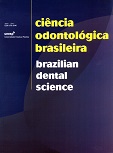Linear dimensional change in acrylic resin disinfected by microwave energy
DOI:
https://doi.org/10.14295/bds.2006.v9i2.519Abstract
The purpose of this study was to characterize the linear dimensional change in specimens made in aluminum rectangular dies (65.0x12.0x3.5mm), with 4 reference demarcations, using the Clássico, Onda-Cryl and QC-20 brands of acrylic resin. Wax patterns with 67.0x15.0x5.0mm were embedded in metallic or plastic flasks with stone gypsum, according to the conventional technique. After stone gypsum setting, the wax molds were removed and the aluminum dies impressed in the stone gypsum mold with silicone material. The powder/liquid proportion and acrylic resin were manipulated according to manufacturer’s instructions. The metallic flask pressure was achieved using the RS tension method. After polymerization in water at 74OC for 9 hours, ebullition water for 20 minutes or microwave energy (900 W) for 10 minutes, the specimens were cooled at room temperature and then removed from the flasks and submitted to conventional finishing. The distances between the A-B, C-D, A-C, and B-D reference points were measured before and after disinfection by microwave energy (650W for 3 minutes). The linear dimensional evaluation of the distances was performed by the same operator with an Olympus optical comparator microscope, with an accuracy of 0.0005mm. Obtained data were submitted to ANOVA and Tukey’s test (α=.05%). The disinfection by microwave energy did not alter the original linear dimensions of the specimens.Downloads
Downloads
Published
How to Cite
Issue
Section
License
Brazilian Dental Science uses the Creative Commons (CC-BY 4.0) license, thus preserving the integrity of articles in an open access environment. The journal allows the author to retain publishing rights without restrictions.
=================




























